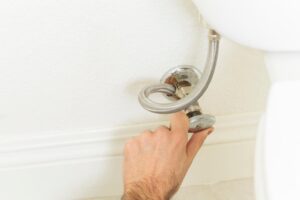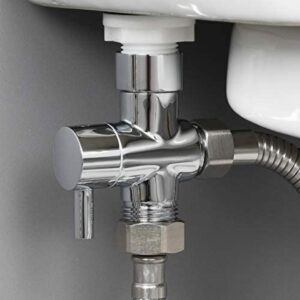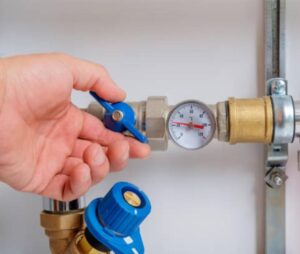Table of Contents
Why is my bidet not spraying?
If your bidet is not spraying, there could be several potential reasons for this issue. Here are some common troubleshooting steps to help identify and resolve the problem:
-
Check the Water Supply: Ensure that the water supply valve for the bidet is fully open. Sometimes, the valve may accidentally get closed or partially closed, restricting water flow to the bidet. Verify that the water supply line is properly connected and that there are no kinks or blockages in the hose.
-
Clear Any Blockages: Examine the bidet nozzle or spray head for any obstructions. Sometimes, mineral deposits or debris can accumulate and clog the nozzle, preventing water from flowing properly. Use a soft brush or toothbrush to gently clean the nozzle, removing any buildup that may be causing the blockage.
-
Check for Water Pressure Issues: Insufficient water pressure may also cause the bidet not to spray effectively. Ensure that the water pressure in your home or the specific water source for the bidet is sufficient. If the water pressure is low, you may need to address the underlying plumbing issue or consider using a pressure-boosting device.
-
Verify the Bidet Settings: Some bidet models come with adjustable settings for water pressure, spray pattern, or temperature. Double-check the bidet controls or knobs to ensure they are set correctly. If necessary, adjust the settings to increase the water pressure or activate the spray function.
-
Electrical Issues (for electric bidets): If you have an electric bidet with additional features like temperature control or built-in heaters, ensure that the bidet is receiving power. Check the power cord, outlet, and any relevant switches or buttons to confirm that the bidet is properly connected and powered on.
-
Seek Professional Assistance: If you have gone through these troubleshooting steps and the issue persists, it may be best to contact the manufacturer’s customer support or consult a professional plumber or technician for further assistance. They will have the expertise to diagnose and address any underlying technical problems with the bidet.
Remember to always follow safety precautions when troubleshooting or working with water and electrical systems.
Why Is My Bidet Pressure Too High?
If you’re one of those people wondering why your bidet’s water pressure is suddenly too high, it might be due to a few different factors.
The first thing you should check is the water pressure in your home, as that can affect the output of your bidet. If the water pressure is too high, you may need to install a pressure regulator on your home’s main water line. This will help to reduce the amount of water pressure coming into your home, and hopefully alleviate the issue with your bidet. If adjusting the water pressure doesn’t seem to fix the problem, it’s possible that the settings on your bidet itself are off. In this case, it’s best to consult the user manual or reach out to customer support for help in recalibrating your bidet.
Another possibility is that the nozzle on your bidet is blocked or clogged. This can be caused by anything from hard water buildup to debris in the water line. If you think this might be the problem, try cleaning the nozzle with vinegar or a small brush. Make sure that there aren’t any clogs in the water line or the bidet itself. A clog can restrict water flow and cause an increase in pressure.
In addition to that, you can try switching to a different nozzle on your bidet. Some bidets come with multiple nozzles, each with its own spray pattern and pressure level.
Check to see if the motor is working properly. If it’s not, that could be causing the water pressure to be too high.
Finally, if you’ve checked all of these things and you’re still having trouble, it’s possible that your bidet itself is faulty. In this case, it’s best to contact the manufacturer or a qualified repair person for assistance.
Toilet water pressure too high?
Too high water pressure in the toilet can cause damage to pipes and lead to overflowing. Homeowners need to be aware of their water pressure levels in order to prevent plumbing issues from occurring.
Water pressure that is too high will force too much water into the toilet bowl and can result in a rapid overflow. High water pressure can also cause damage inside the tank, leading to malfunctioning components such as fill valves, flappers and flush levers. This could also lead to an increase in monthly costs for maintenance and repairs if not addressed quickly.
To prevent these issues from happening, homeowners should check their home’s water pressure by installing a simple gauge onto their main supply line or have it checked by a professional plumber. The ideal pressure level should be between 40 and 60 pounds per square inch (PSI).
Few ways to Lower the Bidet Water Pressure
If you have a bidet, you may have noticed that the water pressure tends to be quite strong. While this can be a good thing, it can also be a bit too much for some people. If you find that the water pressure is too strong for your liking, there are a few things you can do to lower it.
Partially Close the Toilet Shutoff Valve
 one way to fix the issue is by partially closing the toilet shutoff valve. Doing this will lower the water pressure of the bidet, making it more comfortable to use.
one way to fix the issue is by partially closing the toilet shutoff valve. Doing this will lower the water pressure of the bidet, making it more comfortable to use.
To partially close the shutoff valve, start by turning it all the way to the right until it stops. Then, turn it back to the left about a quarter of a turn. This should be enough to lower the water pressure without completely shutting off the flow of water. If you need to make further adjustments, simply turn the valve a little more to the left until you’re happy with the pressure.
Adjust the T-Valve
 If you have a bidet in your bathroom, and you find that the water pressure is too high. It can be adjusted by turning the T-valve to the left. Doing this will lower the water pressure and make it more comfortable to use the bidet.
If you have a bidet in your bathroom, and you find that the water pressure is too high. It can be adjusted by turning the T-valve to the left. Doing this will lower the water pressure and make it more comfortable to use the bidet.
To adjust the T-valve, first locate it. First, locate the T-valve on your bidet. It should be near the water supply line.
Once you have found it, use a wrench to loosen the nut that secures the valve handle in place. Then turn the valve clockwise to lower the water pressure. Repeat this process until you have achieved the desired water pressure. Once you’re finished, tighten the nut to secure the valve handle in place.
If you have any questions about how to adjust your T-valve, please consult your bidet’s instruction manual.
Consider Installing Home’s Water Pressure Regulator
 There are a few things to keep in mind when choosing a water pressure regulator for your home. First, you’ll need to find one that is compatible with the type of plumbing in your home. Second, you’ll need to make sure that the regulator is able to handle the flow rate of your bidet. Finally, you’ll want to choose a regulator that is easy to install and use.
There are a few things to keep in mind when choosing a water pressure regulator for your home. First, you’ll need to find one that is compatible with the type of plumbing in your home. Second, you’ll need to make sure that the regulator is able to handle the flow rate of your bidet. Finally, you’ll want to choose a regulator that is easy to install and use.
Installing a water pressure regulator in your home can be a great way to improve the comfort and usability of your bidet. By taking the time to choose the right regulator for your needs, you can ensure that your bidet will provide years of enjoyment.
Here’s what you need to know about installing a water pressure regulator in your home.
The first step is to determine whether you have high water pressure. You can do this by checking the pressure gauge on your waterline. If it reads above 80 psi (pounds per square inch), then you have high water pressure.
High water pressure can cause a number of problems in your home, including leaks in your pipes and fixtures. It can also make it difficult to take a shower or brush your teeth without being blasted by a strong stream of water.
This can be beneficial in a number of ways. For one, it can help to extend the life of the bidet. Additionally, it can help to make the bidet more comfortable to use, as well as improve its overall performance.
Try the Soft Spray Mode
 If you have a handheld bidet in your bathroom, you may not be using it to its fullest potential. Sometimes, the stream of water from a bidet can be too strong. If you’re finding that the pressure is too much for you, try switching to the soft spray mode. This will lower the water pressure and make your experience more comfortable.
If you have a handheld bidet in your bathroom, you may not be using it to its fullest potential. Sometimes, the stream of water from a bidet can be too strong. If you’re finding that the pressure is too much for you, try switching to the soft spray mode. This will lower the water pressure and make your experience more comfortable.
Many people don’t realize that the water pressure of a bidet can be adjusted. but the water pressure of a bidet can be adjusted to your preference. If you find that the default setting is too strong for you, go ahead and lower the water pressure. On most models, there will be a knob or button that you can use to adjust the pressure. Once you’ve found a setting that’s comfortable for you, stick with it and enjoy a more relaxing experience.
Use an External Water Filter
An external water filter can be a great way to lower the water pressure of your bidet. By attaching an external water filter to your bidet, you can reduce the amount of water that is coming through the system and this will help to lower the pressure. There are a few things that you need to keep in mind when using an external water filter, however. First, you need to make sure that the filter is properly attached to the bidet. Second, you need to ensure that the water pressure is set low enough so that it does not damage the bidet or cause any leaks. External water filters are relatively inexpensive and can be found at most hardware stores. If you’re not sure whether or not your home has high water pressure, you can ask a plumber to check it for you. If they determine that the pressure is too high, they can recommend an external water filter that would be suitable for your needs.
How to stop a bidet from leaking?
If you’re experiencing a leak from your bidet, you can try the following steps to troubleshoot and potentially stop the leak:
-
Identify the source of the leak: Determine where the leak is originating from. Check the connections, hoses, valves, and any other components of the bidet system to locate the source of the problem. It could be a loose connection, a damaged hose, or a faulty valve.
-
Tighten connections: If you find any loose connections, use a wrench or pliers to tighten them gently. Be careful not to overtighten, as it may cause damage. Check if the leak stops after tightening the connections.
-
Inspect hoses: Examine the hoses connected to the bidet. Look for any cracks, holes, or damage. If you find any, replace the hose with a new one. Ensure that the replacement hose is the correct size and compatible with your bidet model.
-
Check washers and seals: Leaks can occur if the washers or seals within the bidet components are worn out or damaged. Inspect the washers and seals in the connections, valves, and other areas of the bidet. Replace any faulty washers or seals with new ones.
-
Adjust water pressure: Excess water pressure can sometimes cause leaks. Check if your bidet has an adjustable water pressure setting. Reduce the water pressure to a lower setting and see if the leak improves or stops. Consult the bidet’s user manual for instructions on adjusting the water pressure.
-
Replace faulty components: If the leak persists despite your efforts, you may need to replace a faulty component, such as a valve or a diverter. Contact the manufacturer or a professional plumber for guidance on identifying and replacing the specific parts.
-
Seek professional help: If you are unsure about troubleshooting or unable to resolve the leak on your own, it’s best to contact a professional plumber who specializes in bidet installations and repairs. They will have the expertise to diagnose and fix the issue effectively.
Remember to turn off the water supply to the bidet before attempting any repairs or replacements to avoid any potential flooding or accidents.
